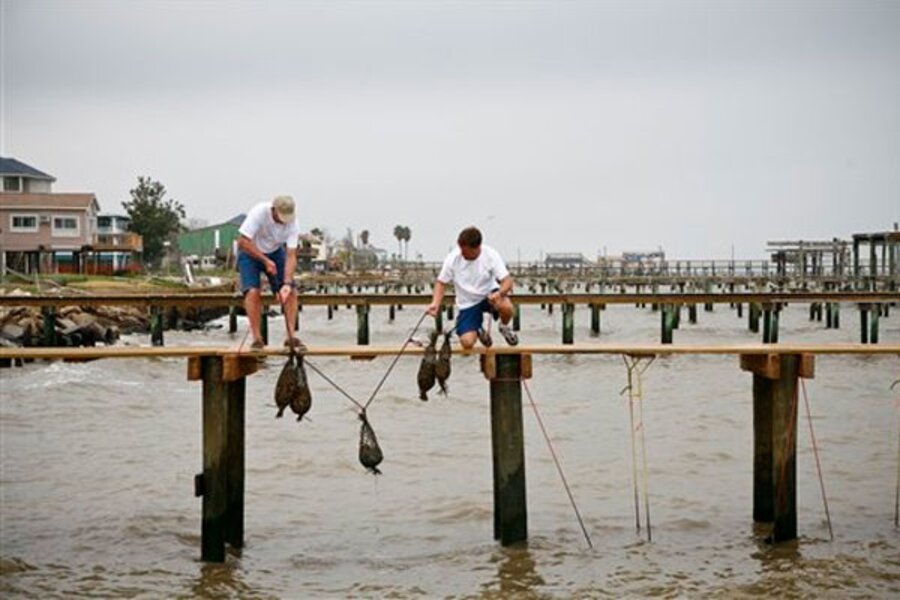Oyster 'gardening' restores reefs after hurricane
| SAN LEON, Texas
Below the choppy gray waters of a small peninsula jutting into Galveston Bay, 200 mesh bags dangle, filled with shucked oyster shells and a whole lot of hope.
Six families, who each have bay-front homes with long wooden-plank piers, stuffed the bags with oyster shells. They then tied the bags to the newly rebuilt fishing piers and dropped them into the water.
These families are experimenting with "oyster gardening" — using old shells to provide the hard surface upon which oyster larvae can attach and grow.
This is one of several creative projects, paid for by federal and state grants, under way to restore a small portion of the 8,000 acres of oyster reefs killed when Hurricane Ike buried them in sediment a year ago.
Oysters are important to the Texas economy as a food and are also efficient filters that remove contaminants from the water as they feed. A single oyster filters 50 gallons a day.
The San Leon project has promoted a kind of communal bonding, as these neighbors try to reclaim the life they knew before Ike submerged their peninsula under several feet of water.
When Edwina and Marvin Peyton learned about oyster gardening from a Texas Parks and Wildlife e-mail, they were thrilled. They were just about finished restoring their home and 100-foot pier, and now there might actually be something they could contribute to the bay's restoration.
"It's been very educational," said Mr. Peyton, as he pulled a mesh bag onto his pier to examine it. "I've had to learn about the sex life of oysters. Something I hadn't taken into consideration before."
Oysters, for instance, can change their sex during stressful times so that they can produce more eggs. The eggs are fertilized in the water and then the larvae swim around until they find a hard surface where they can plant their muscular foot and grow.
Mr. Peyton pointed to the inside lining of a shucked shell where a juvenile oyster had cemented itself. It had grown from a brownish spot the size of a match head to almost 2 inches in diameter.
"If you don't know what you're looking for, you might not see anything but dead old shells," he says.
But oysters are not the only things growing inside there. Numerous tiny crabs and shrimp the size of a thumbnail scurry from the bag laid on the pier. About every two weeks, San Leon residents must raise the bags, rinse them and leave them in the sun to get rid of predators that might eat the babies.
"We want to re-establish the oyster reefs that used to be near our shore years ago," says Greg Tate, another home-owner participating in the $92,000 project, which began at the end of June. "We see the new reefs as a foundation so that future generations can enjoy the bay."
The mesh bags — now filled with thriving baby oysters — were used to seed artificial oyster reefs formed from tons of river rock dumped around the piers.
These reefs are being formed within 200 feet of residential piers, which makes them off-limits to commercial fishing.
Another benefit of an oyster reef could be improved recreational fishing, says Bill Rodney, an oyster restoration biologist in charge of the San Leon project.
"There's a lot of creatures living on oyster reefs that attract fish from sea trout to red drum," he says.
But most importantly, authorities say, the oysters are critical for cleaning the water. "You can't lose that much biofiltration and not have a decline in Galveston Bay's water quality," says Lance Robinson, a regional director for Texas Parks and Wildlife.
Another oyster restoration project is a 20-acre artificial reef recently created from nine bargeloads of river rock poured into East Bay — the hardest-hit area, where 80 percent of the reefs were smothered.
In addition, nearly $3 million has been set aside to pay commercial anglers in May to rake their dredges over the buried reefs in hopes of pulling oyster shell back to the surface while also adding some artificial reef material.
The artificial reef in East Bay was completed a week ago by spreading 13,000 cubic yards of river rock over 20 acres in 9-foot-deep waters between Port Bolivar in Galveston County and Smith Point in Chambers County.
"We're letting it sit to see what happens. We've already started to see some spat (small larvae) adhering to buoys that we have out there," says Jennie Rohrer, an oyster restoration biologist overseeing the $720,000 East Bay project.
The Peytons, meanwhile, talk about catching a 24-inch red fish off their pier recently, while noting flocks of pelicans and a pod of porpoises have seemed to find plenty of food out there.
"I believe we can get a good reef going in two years," Mrs. Peyton says.
Editor’s note: For more articles about the environment, see the Monitor’s main environment page, which offers information on many environment topics. Also, check out our Bright Green blog archive and our RSS feed.





